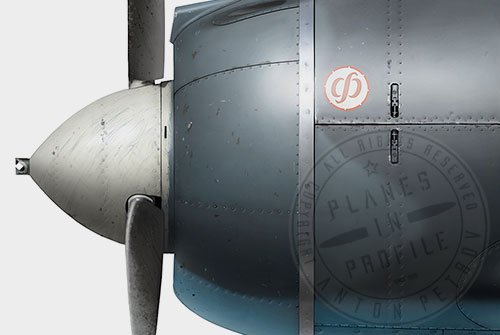(Lavochkin)
La-5F
La-5F was the first of two main modifications of Lavochkin’s La-5 variant. It entered production in late 1942, first as “Type-37”- with a high “back” fuselage (as per the early La-5) and then from around April 1943 as “Type-39” with a lowered “back” fuselage and a new canopy design. It was in production until the end of 1943 with 4147 La-5F planes built in total[1], this includes the Type-37 and the Type-39 planes combined.
La-5F’s most substantial improvement over the La-5 was the change of the engine from ASh-82 (a.k.a. M-82) to the ASh-82F Engine (a.k.a. M-82F) with improved ‘supercharger’ and oil system. The ‘F’ in the Ash-82F engine designation stood for ‘Forsirovaniy’ which translates to ‘Forced or Boosted’. The ‘boosted’ engine increased the supercharger’s output to 1,760 horsepower below 10,000 feet (3,048 meters). The engine could run at such power with no limitations, whereas the unboosted M-82A of the La-5 could operate at full power for only several minutes [2].
The symbol ‘Ф’ which is a cyrillic letter ‘F’ , inclosed in a circle, was painted onto the cowling and the tip of the tail of the planes to help identify them as La-5F, though not always.
Cyrillic letter ‘F’ on the engine cowling. It was sometimes painted as red over a white circle and sometimes as simply white with no background (white) colour.
The ‘F’ symbol that appeared on the tip of the tail was usually painted in white, without the background colour.
As mentioned above, the first La-5F planes (type 37) retained the ‘high back’ airframe inherited all the way back from LaGG-3 and used in the early La-5, but it was soon redesigned and the new planes received the designation of ‘type 39’. The improved airframe of the La-5F ‘type 39’ allowed the pilot a greater field of vision due to the lowering of the fuselage behind the cockpit and the lengthening of the canopy, while adding a bulletproof glass to the front glass panel and behind the pilot’s head thus increasing pilot’s protection. The new canopy was also fitted with an emergency release system from the 38th series onwards.
La-5F ,Type-37, retained the ‘high back’ of the earlier La-5s, which they inherited from the LaGG-3.
La-5F, Type-39. The new design included a ‘lowered back’ and the new and improved canopy.
The angle of turn of the ailerons was tweaked. In the earlier La-5s the angle up and down was symmetrical (about 35 degrees each way), but in the La-5F the upward turn angle was increased and the downward was decreased. The surface area of the elevators was increased and the trimmer on the left elevator was eliminated. The movement in the shock absorbers on the landing gear was increased. The internal sealing of the airplane was improved which helped the plane acquire more speed (approximately 24km/h more). The oil cooler ducts were reshaped. Antena mast was angled forward for decreased air resistance. The cannon firing system was changed from pneumatic PS-1 system to pneuma-electric PES-1 (But was later reverted back) [3]. Various other modifications were made in an attempt to reduce the weight of the airplane and to increase its performance characteristics. The end result was an airplane that was superior to its predecessor (La-5) in all respects, including climb rate, conditions for the pilot and its speed, which was faster up to 40km/h.
The La-5F was developed late in 1942 and arrived at the frontline in February 1943. It was able to challenge the Messerchmitt Bf 109G-2 and the Focke-Wulf Fw 190A-4 on more or less equal terms, while at tree-top height it was even faster. [4] It was produced in 1942-1943.
La-5F were flown by some of the best Allied fighter pilots of WW2, including Kirill Evstigneev and Ivan Kozhedub (number 5 and number 1 top-scoring Allied Fighter Aces) who achieved many of their victories behind the controls of their La-5Fs.
SPECIFICATIONS [5]
GENERAL CHARACTERISTICS
Crew: 1
Length: 8.67 m
Wingspan: 9.76 m
Height: 2.54 m
Wing area: 17.51 m2
Gross weight: 3,227 kg
Powerplant: 1 × Shvetsov M-82F
PERFORMANCE
Maximum speed: 590 km/h at 6,500 m, 514/551 km/h at sea level
Range: 600 km
Service ceiling: 9,500 m
Rate of climb: 820 m/min
ARMAMENT
Guns: 2 × 20 mm ShVAK cannon
Bombs: 2 × bombs, up to 100 kg each (FAB-100)
[1] The number of La-5Fs built is taken from the book called ‘Lavočkin La-5’ by Miloš Veštšik, page 39. Published by MBI in 2006.
[2]https://vvsairwar.com/2016/08/18/the-development-of-the-lavochkin-la-5/
[3] The list of improvements to the la-5F is based on Aviakollektsyya’s La-5Fighter, part 1, by N.Kruglov, V Kotelnikov, M. Orlov, published by “Modelist Konstruktor” magazine, 2018. page 14-15
[4] Bergström, Christer. Black Cross – Red Star, Air War over the Eastern Front. Volume 4. Stalingrad to Kuban. Vaktel Books, 2019. ISBN 978-91-88441-21-8
[5] Specifications are derived from various sources. “Performance” specifications are derived from the book called ‘Lavochkin La-5’ by Miloš Veštšík, published by MBI in 2006. Page 108




